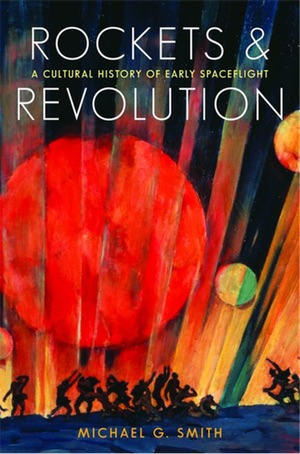Review: Rockets and Revolutionby Jeff Foust
|
| “…even at the turn of the 20th century, there was a complex interchange of ideas among [spaceflight] pioneers in America, Europe, and Russia that is not widely recognized.” |
Those approaches, though, are limiting, Purdue University history professor Michael Smith argues in the introduction of his new book, Rockets and Revolution. “Science without the culture does not make much sense,” he writes. “By the turn of the [20th] century they were invading each other’s realms.” His book, rather than a history of the early development of rocketry and spaceflight, is more of a “free history of ideas” that looks at both the technical and cultural history of the field.
And, indeed, the history reviewed by Smith in his book is a broader cultural examination of spaceflight, one that often spends far more time on the culture—arts and literature—than the science and technology. He examines activities in Europe, Russia/Soviet Union, and the United States from the late 19th century through the 1930s, stopping at the outbreak of World War II and US-Soviet Cold War that followed.
The argument Smith makes in the book is that, even at the turn of the 20th century, there was a complex interchange of ideas among pioneers in America, Europe, and Russia that is not widely recognized. Rather than being lone geniuses, they were influenced by what others were doing. “None of these thinkers was self-made,” he writes of Tsiolkovsky, Oberth, and Goddard. “No one ever really is.”
If anything, Russia—primarily in the guise of the early Soviet Union—had the advantage, he argues: it had access to written works from Europe and America, but Russian works were not well known in return. The early Soviet Union also had a desire to catch up technologically with the West and demonstrate the superiority of communism, which provided additional interest in rocketry. Its firsts in rocketry, Smith says, predate Sputnik, including the first “theorist of spaceflight” and first popular works on the topic. (Some of those firsts, though, like Tsiolkovsky’s works, predate the Soviet Union.) “Priority does count,” he writes, although its value can be questioned.
Americans, Smith writes, not only were less aware of Russian/Soviet space studies—be they in the early 20th century, or decades later as the Space Age truly began—but were also unaware of how much influence their own efforts had on Russia. In the 1970s, he says, American historians translating Russian works from early in the century thought they had found stunning revelations of early Russian space science, only to find much of it was actually based on what had been published previously in the West. “Americans looked for distant origins and priorities in the Russians, only to find nothing more than themselves.”
| Smith says that the parabola is the central theme of the book. “It became the perfect arrow, that human saltation, or ‘leap,’ through space and time,” he writes. |
Some have questioned whether Smith’s book follows too closely another work on the pre-history of Russian spaceflight, Asif Siddiqi’s Red Rockets Glare: Spaceflight and the Russian Imagination, 1857—1957 (see “Dead trees live!”, The Space Review, December 22, 2014). The scope of the two books is somewhat different: Smith looks at activities and literature in the US and Europe as well as Russia (although Russia is perhaps weighted more heavily), but stops his studies in the late 1930s, with only a brief discussion of post-war activities leading up to Sputnik in the conclusion. However, as Dwayne Day notes in his earlier essay, it may be interesting to more closely compare and contrast the two works, an effort beyond the scope of this review.
Smith’s decision to end the book in the late 1930s is odd, since it overlooks the key factors that drove the development of the first launch vehicles and spacecraft: World War II and the Cold War. The two biggest figures of the early Space Race, Korolev and von Braun, have only cameos in this work, while many of the major figures in it, like Goddard, had little influence on that future. (“There is no direct line from Goddard to present-day rocketry,” Theodore von Kármán wrote in his memoirs, in a passage quoted by Smith.)
Smith, in the introduction, says that the parabola is the central theme of the book. “It became the perfect arrow, that human saltation, or ‘leap,’ through space and time,” he writes. But the parabola is an odd choice for a trajectory, as it is not a particularly useful one: too fast to go into an elliptical orbit, too slow to escape in any meaningful time frame. It ascends, never to return, but also never to escape. Moreover, invert the parabola, and you get an arc that ascends, only to peak and descend in mirror image to its ascent. That is probably not the theme that Smith intends in his book, but also may be more apt, perhaps, for at least some aspects of spaceflight.
